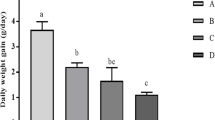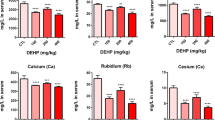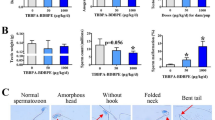Abstract
The present study was performed to investigate the potential toxic effects of prenatal exposure to 4-tert-octylphenol (OP) on liver, kidney, spleen, and hematologic parameters of male and female rats in adult life. The rats were treated with OP subcutaneously in utero at doses of control (vehicle, corn oil), 100 or 250 mg/kg per day. After birth, the rats were allowed to grow until adulthood and then liver, kidney and spleen were investigated histopathologically. Also the blood collected from rats were analyzed for any hematologic changes. The red blood cells of male and female rats were decreased in 250 mg/kg per day OP-treated group compared with the control group. μ-RBC of male rats in high dose treatment groups were increased significantly compared with the controls and 100 mg/kg per day treatment groups. μ-RBC of female rats in treatment groups were increased in a dose-dependent manner compared with the controls. In liver, kidney and spleen of male and female rats treated with OP, degeneration of hepatic parenchyma, tubular degeneration and hemorrhage were observed in histopathologic examination. The hemosiderin deposition in spleen of the high-dose group was increased in both male and female rats. In conclusion, findings of this study demonstrate that maternal administration of high doses of OP causes adverse effects on spleen and liver tissues of male and female offsprings at adulthood. Specifically, OP caused decreases in the number of red blood cells indicated by increased destruction in the spleen.




Similar content being viewed by others
References
Aydoğan M, Barlas N (2006) Effects of maternal exposure 4-tert-octylphenol exposure on the male reproductive tract of male rats at adulthood. Reprod Toxicol 22:455–460
Blake CA, Boockfor FR (1997) Chronic administration of environmental pollutant 4-tert-octylphenol to adult male rats interferes with the secretion of Luteinizing hormone, Follicle-stimulating hormone, prolactin, and testosterone. Biol Reprod 57:255–266
Blake CA, Boockfor FR, Nair-Menon JU, Millette FC, Raychoundhury SS, McCoy GL (2004) Effects of 4-tert-octylphenol given in drinking water for 4 months on the male reproductive system of Fischer 344 rats. Reprod Toxicol 18(1):43–51
Boockfor FR, Blake CA (1997) Chronic administration of 4-tert-octylphenol to adult male rats causes shrinkage of the testes and male accessory sex organs, disrupts spermatogenesis, and increases the incidence of sperm deformities. Biol Reprod 57:267–277
Certa H, Fedtke N, Wiegand H, Muller A (1996) Toxicokinetics of p-tert-octylphenol in male Wistar rats. Arch Toxicol 71:112–122
Cesta MF (2006) Normal structure, function, and histology of the spleen. Toxicol Pathol 36:455–465
Chapin R, Delaney J, Lanning L, Davis B, Mintz N, Wolfe G (1999) The effects of 4-nonylphenol in rats: a multigeneration reproduction study. Toxicol Sci 52:80–91
Daidoji T, Inoue H, Kato S, Yokota H (2003) Glucoronidation and excretion of nonylphenol in perfused rat liver. Drug Metab Dis 31:993–998
Dukes PP, Goldwasser E (1961) Inhibition of erythropoiesis by estrogens. Endocrinology 69:21–29
Gad SC, Weil CS (1989) Statistics for toxicologists. In: Hayes AW (ed) Principles and methods of toxicology, 2nd edn. Raven Press, New York, pp 435–483
Haavisto TE, Adamsson NA, Myllymäki SA, Toppari J, Paranko J (2003) Effects of 4-tert-octylphenol, 4-tertbutylphenol, and dietylstilbestrol on prenatal testosterone surge in the rat. Reprod Toxicol 17:593–605
Harazono A, Ema M (2001) Effects of 4-tert-octylphenol on initiation and maintenance of pregnancy following oral administration during early pregnancy in rats. Toxicol Lett 119:79–84
Hernández-Rodríguez G, Zumbado M, Luzardo OP, Monterde JG, Blanco A, Boada LD (2007) Multigenerational study of the hepatic effects exerted by the consumption of nonylphenol- and 4-octylphenol-contaminated drinking water in Sprague–Dawley rats. Environ Toxicol Pharm 23:73–81
Jobling S, Sumpter JP (1993) Detergent components in sewage effluent are weakly estrogenic to fish—an in-vitro study using rainbow-trout (Oncorhynchus mykiss) hepatocytes. Aquat Toxicol 27:362–372
Katsuda S, Yoshida M, Isagawa S, Asagawa Y, Kuroda H, Watanabe T, Ando J, Takahashi M, Maekawa A (2000) Dose- and treatment duration-related effects of p-tert-octylphenol on female rats. Reprod Toxicol 14:119–126
Khurana S, Ranmal S, Ben-Jonathan N (2000) Exposure of newborn male and female rats to environmental estrogens: delayed and sustained hyperprolactinemia and alterations in estrogen receptor expression. Endocrinology 141(12):4512–4517
Mantovani A (2002) Hazard identification and risk assessment of endocrine disrupting chemicals with regard to developmental effects. Toxicology 181–182:367–370
Montgomery CA, Seely JC (1990) Kidney. In: Boorman G, Eustis S, Elwell M, Montgomery A, McKenzie W (eds) Pathology of the Fisher rat. Academic Press, San Diego, pp 127–154
Nair-Menon JU, Campbell GT, Blake CA (1996) Toxic effects of octylphenol on cultured rat and murine splenocytes. Toxicol App Pharm 139(2):437–444
Nair-Menon JU, Campbell GT, McCoy GL, Blake CA (1999) Interactions between estrogen, tamoxifen, octylphenol, and two polychlorinated biphenyls in murine splenocytes. Life Sci 65(11):1125–1133
Peterson RE, Cooke PS, Kelce WR, JrE Gray (1997) Environmental endocrine disruptors. In: Sipes IG, McQueen CA, Gandolfi AJ (eds) Comprehensive toxicology, vol 10. Elsevier, Cambridge, pp 181–192
Pryor JL, Hughes C, Foster W, Hales BF, Robaire B (2000) Critical windows of exposure for children’s health: the reproductive system in animals and humans. Environ Health Persp 108:491–503
Suttie AW (2006) Histopathology of the spleen. Toxicol Pathol 34:466–503
Tan BLL, Mohd MA (2003) Analysis of selected pesticides and alkylphenols in human cord blood by gas chromatograph-mass spectrometer. Talanta 61:385–391
Toppari J, Larsen JC, Christiansen P, Giwercman A, Grandjean P, Guillette LJ Jr, Jégou B, Jensen TK, Jouannet P, Keiding N, Leffers H, McLachlan JA, Meyer O, Müller J, Meyts ER, Scheike T, Sharpe R, Sumpter J, Skakkebæk NE (1996) Male reproductive health and environmental xenoestrogens. Environ Health Persp 104(Suppl 4):741–803
White R, Jobling S, Hoare S, Sumpter J, Parker M (1994) Environmentally persistent alkylphenolic compounds are estrogenic. Endocrinology 135:178–182
Ying G-G, Williams B, Kookana R (2002) Environmental fate of alkylphenols and alkylphenol ethoxylates―a review. Environ Int 28:215–226
Zumbado M, Boada LD, Torres S, Monterde JG, Díaz-Chico BN, Afonso JL, Cabrera JJ, Blanco A (2002) Evaluation of acute hepatotoxic effects exerted by environmental estrogens nonylphenol and 4-octylphenol in immature male rats. Toxicology 175:49–62
Acknowledgments
This research was partially supported by the Scientific Research Unit of University of Hacettepe (01 02 601 003 Project).
Author information
Authors and Affiliations
Corresponding author
Rights and permissions
About this article
Cite this article
Barlas, N., Aydoğan, M. Histopathologic effects of maternal 4-tert-octylphenol exposure on liver, kidney and spleen of rats at adulthood. Arch Toxicol 83, 341–349 (2009). https://doi.org/10.1007/s00204-008-0354-2
Received:
Accepted:
Published:
Issue Date:
DOI: https://doi.org/10.1007/s00204-008-0354-2




